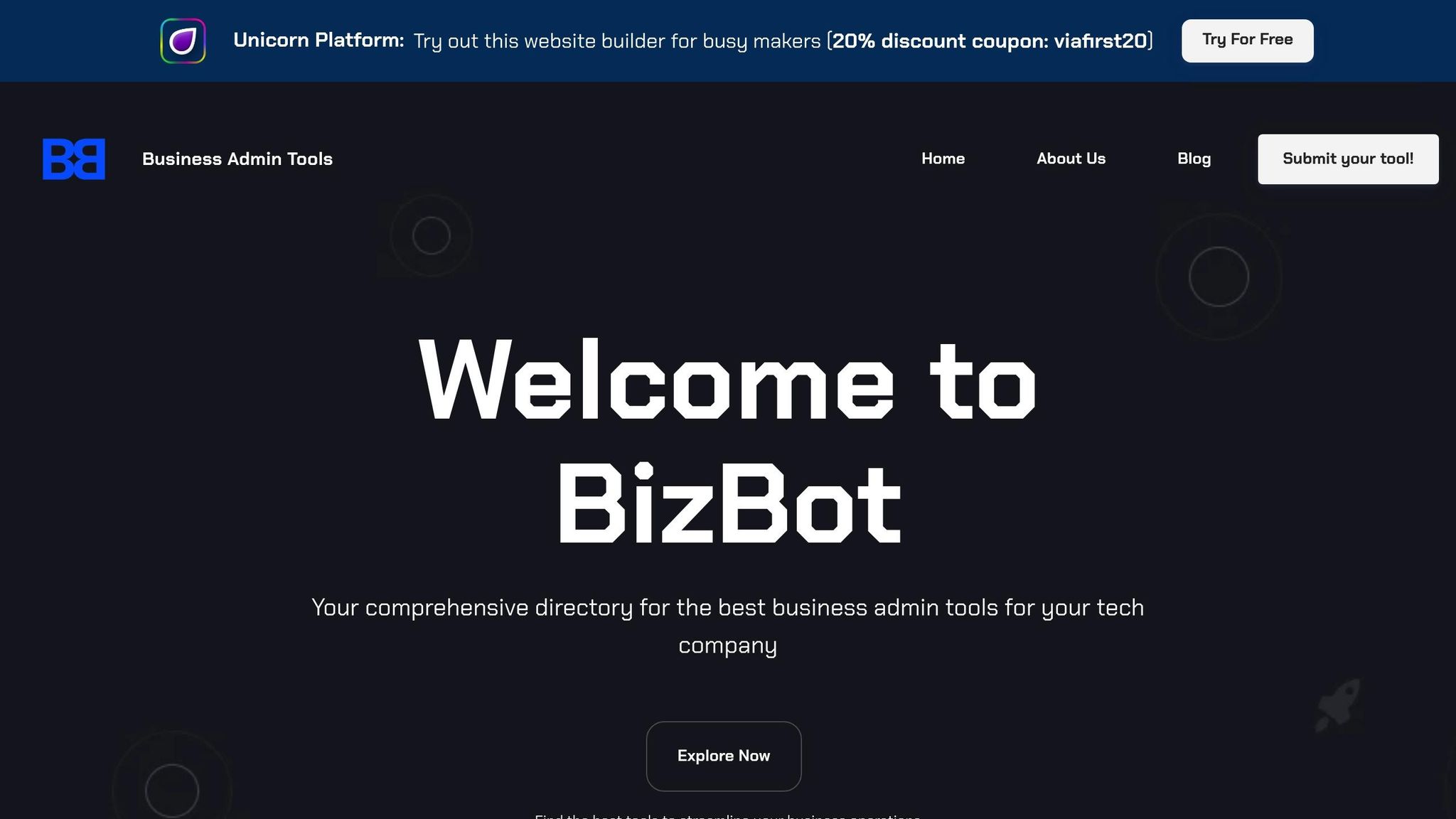Embedded analytics integrates data insights directly into the tools you already use, making decision-making faster and more intuitive. Instead of switching between platforms, users can access real-time data and actionable insights within their workflow. Here's what you need to know:
- What It Is: Analytics built into everyday tools like CRMs and EHRs, eliminating the need for separate dashboards.
- Why It Matters: It speeds up decisions, reduces costs, and empowers employees with instant access to insights.
- Key Trends: AI, machine learning, and generative AI are transforming analytics with predictive insights, automated reports, and natural language queries.
- Industries Benefiting: Finance, healthcare, and e-commerce are leveraging embedded analytics for risk monitoring, patient care, and personalized shopping experiences.
- Features to Look For: Self-service dashboards, easy integration, scalability, and strong security.
Embedded analytics is reshaping how businesses use data, making it accessible, actionable, and part of everyday operations.
The Future of Software Development in 2024 & Beyond
Major Trends Driving Embedded Analytics Forward
The world of embedded analytics is transforming quickly, fueled by new technologies that are changing the way businesses use data. These trends are pushing analytics toward more proactive and integrated decision-making, making it easier for organizations to act on insights in real time.
AI and Machine Learning Integration
Artificial intelligence (AI) and machine learning (ML) are taking embedded analytics to the next level by not only interpreting past data but also forecasting future outcomes and suggesting actions. These systems are designed to refine their predictions as new data becomes available, removing the need for constant manual updates. Instead of just explaining what happened, they now help predict what’s likely to happen and recommend what to do about it.
Modern platforms use machine learning to uncover patterns in historical data, making it possible to predict customer behavior, anticipate inventory needs, or prepare for market changes. This is especially useful for businesses aiming to stay ahead in competitive industries.
Prescriptive analytics is an exciting development in this space. Unlike predictive analytics, which forecasts possible outcomes, prescriptive systems recommend specific actions to achieve desired results. For instance, a tool might analyze sales trends and suggest which products to promote, which customer segments to target, and the best timing for campaigns to maximize impact.
Machine learning also powers anomaly detection, which works quietly in the background. These systems can flag unusual patterns or outliers in real time, alerting users to potential problems or opportunities. This capability allows businesses to address issues early, seize new opportunities, and maintain quality - all without needing constant oversight.
The integration of these advanced features is becoming easier, too. Many platforms now offer pre-trained models that are ready to use, saving organizations from the hassle of building their own machine learning systems.
On top of these advancements, generative AI is making data interaction even more intuitive.
Generative AI and Automated Insights
Generative AI is changing how people interact with analytics by enabling natural language queries. Instead of needing to write complex queries or interpret detailed charts, users can simply ask questions in plain English and get clear, actionable answers.
But generative AI doesn’t stop at simple Q&A. It can also generate detailed reports, executive summaries, and explanations for complex data patterns. Imagine feeding a dataset into the system and receiving a narrative that not only explains the numbers but also highlights why they matter to your business.
Automated insight generation is another game-changer. These systems don’t wait for users to ask questions - they actively monitor data and surface key findings, such as emerging trends, potential risks, or new opportunities. This proactive approach ensures businesses stay informed without needing to dig through data themselves.
Generative AI also excels at contextual recommendations. By understanding a user’s role, tasks, and goals, it delivers insights tailored to their specific needs. For example, a sales manager might get tips on lead conversions, while a finance director receives alerts about budget discrepancies or cash flow trends.
This natural language capability makes analytics more accessible to employees who may not be comfortable with traditional data tools. Users can engage in a conversational manner, asking follow-up questions and exploring details without needing technical expertise.
To make these insights even more impactful, the focus on real-time data access ensures that decisions are based on the most current information available.
Real-Time Data Access and Analysis
The need for instant data processing is driving major advancements in embedded analytics infrastructure. Businesses today require insights based on what’s happening in the moment, not on data that’s hours or days old.
Modern analytics platforms are designed to process live data and deliver immediate insights. This is particularly crucial in industries like e-commerce and finance, where real-time decisions can significantly affect outcomes.
Technologies such as event-driven analytics and in-memory computing allow for instant responses to data patterns. For example, customer service systems can quickly escalate issues when sentiment analysis detects dissatisfaction, enabling faster resolutions.
Advancements in real-time processing have also made it more accessible and reliable. Stream processing engines now handle massive amounts of data per second, all while maintaining accuracy.
These real-time capabilities also foster better collaboration. Teams can work with the same live data simultaneously, ensuring everyone is aligned and working with the most up-to-date information. This eliminates confusion that often arises when different team members rely on outdated reports or datasets.
Edge computing is further enhancing real-time analytics by processing data closer to its source. This reduces latency and bandwidth use, which is especially beneficial for businesses with distributed operations or those relying on IoT devices and sensors.
With these technological strides, embedded analytics is becoming more powerful and easier to use, paving the way for broader adoption across industries and business roles.
Key Features of Modern Embedded Analytics Platforms
Modern embedded analytics platforms are designed to adapt to today's demands while keeping pace with organizational growth.
Self-Service Customization
These platforms enable users of all skill levels to create and tweak dashboards without needing IT assistance. This ensures that those closest to the data can focus on the metrics that matter most to their work.
They often include:
- Drag-and-drop interfaces for intuitive design.
- Pre-built dashboard templates for quick setup.
- Guided analytics that suggest relevant visualizations.
- Role-based customization to tailor the experience for different users.
For example, a marketing coordinator might see simplified chart options and campaign-specific templates, while a data analyst gains access to advanced statistical tools and custom calculation builders. These features also seamlessly integrate with existing software, making workflows smoother and more efficient.
Easy Integration Capabilities
For embedded analytics to be effective, they must integrate effortlessly with existing systems, avoiding data silos and minimizing custom development needs.
APIs and SDKs are essential here, allowing developers to embed analytics directly into current applications. This makes insights feel like a natural extension of the user's workflow instead of a separate tool. Many platforms also include pre-built integrations for popular software like CRM systems, accounting tools, and e-commerce platforms, often requiring just a few clicks to connect.
Other integration highlights include:
- White-labeling options to align analytics with an organization’s branding.
- Configuration wizards to simplify data source connections and dashboard setup.
- One-click deployment for getting analytics up and running quickly.
Data synchronization is another key feature, offering real-time updates for time-sensitive needs or scheduled batch updates for less urgent reporting. This flexibility helps businesses balance performance requirements with costs and system resources.
Scalability and Security
To remain effective over time, embedded analytics platforms must scale alongside growing businesses while ensuring data security.
Scalability is achieved through elastic scaling, which adjusts computing resources based on demand. This is particularly useful for businesses with seasonal spikes or rapid growth. Usage-based pricing models also help organizations expand without committing to costly enterprise packages prematurely.
Security is equally critical. Modern platforms include:
- End-to-end encryption for data in transit and at rest.
- Single sign-on (SSO) integration for streamlined user access.
- Granular permissions to control who can access or modify specific data.
For businesses operating in regulated industries, platforms often come equipped with compliance tools for standards like HIPAA, SOX, or GDPR. Features such as audit trails, data lineage tracking, and automated compliance reporting simplify regulatory adherence.
To ensure reliability, many platforms provide disaster recovery systems, backup solutions, and uptime guarantees - often 99.9% or higher. With redundant infrastructure and automatic failover capabilities, these systems are built to keep analytics running smoothly, even during unexpected disruptions.
How Different Industries Use Embedded Analytics
Embedded analytics has shifted from being a simple reporting tool to a game-changer for various industries. It’s now a critical part of how businesses solve problems, make decisions, and stay ahead of the competition by using data in smarter ways.
Finance
In the financial world, embedded analytics is reshaping how institutions handle risk, serve customers, and make investment decisions. Real-time risk monitoring is a prime example, as today’s fast-moving markets demand instant insights.
Trading platforms now include embedded risk analytics, allowing traders to see portfolio exposure, value-at-risk, and stress test results without juggling multiple tools. This streamlined access reduces errors and keeps firms compliant with regulations.
Portfolio analysis has also taken a leap forward. Investment firms now integrate advanced analytics into client portals, giving investors instant updates on their holdings, performance metrics, and risk levels. This not only saves time but also fosters trust by eliminating the need for manual reporting.
Another area where embedded analytics shines is credit risk assessment. Banks now use predictive analytics within loan origination systems, enabling loan officers to pull up credit scores, default probabilities, and customized loan terms during meetings. This speeds up the loan approval process while maintaining strict risk controls.
Fraud detection has also become lightning-fast, with analytics tools spotting unusual spending patterns or behaviors in milliseconds, helping financial institutions act before issues escalate.
Healthcare
In healthcare, embedded analytics is making a real difference by improving patient care and streamlining operations. Patient data dashboards now provide a full picture of medical histories, treatment plans, and outcomes all in one place.
Embedded tools in electronic health record (EHR) systems are transforming clinical decision-making. These tools analyze patient data in real time, flagging potential drug interactions, recommending evidence-based treatments, and alerting providers to critical changes in a patient’s condition. This integration not only reduces medical errors but also elevates the quality of care.
On the operational side, hospital management is becoming more efficient thanks to real-time dashboards. Administrators can monitor bed occupancy, staff schedules, equipment usage, and patient flow to optimize resources and reduce wait times, ultimately improving satisfaction scores.
Population health management is another area seeing significant benefits. Embedded analytics helps healthcare providers identify high-risk patients, manage chronic conditions, and evaluate the success of preventive care programs. These insights allow for early interventions, reducing the need for costly emergency care.
Even financial processes in healthcare are getting a boost. Embedded analytics in billing systems helps optimize claims processing and improve reimbursement rates.
E-Commerce
E-commerce companies are using embedded analytics to fine-tune customer experiences and streamline operations. Customer behavior analysis has reached new levels of sophistication, with analytics built directly into platforms to track user journeys, find points where conversions drop off, and personalize product recommendations.
Real-time personalization is now the norm. By analyzing browsing history, purchase patterns, and demographic data, e-commerce sites can customize everything from product displays to promotions. This tailored approach leads to higher conversion rates and boosts customer loyalty.
Inventory management is another area benefiting from embedded analytics. Retailers use demand forecasting tools to adjust stock levels based on seasonal trends, promotions, and supplier timelines. This ensures they avoid overstocking or running out of popular items, saving costs and keeping customers happy.
Supply chain analytics have also advanced. E-commerce platforms now embed tools that provide real-time updates on logistics, tracking delivery times, carrier performance, and customer satisfaction. This data helps refine shipping strategies and enhance the overall shopping experience.
Marketing efforts are becoming more precise, too. Embedded analytics give real-time insights into campaign performance, customer acquisition costs, and ad returns. Marketers can adjust strategies on the fly, ensuring budgets are spent wisely.
Customer service teams are also benefiting. Tools like sentiment analysis and support ticket analytics help identify recurring issues, track resolution times, and predict satisfaction levels. This allows companies to address problems proactively and improve service quality.
sbb-itb-d1a6c90
How to Choose and Set Up Embedded Analytics Solutions
Selecting the right embedded analytics solution is essential to making the most of its capabilities. To ensure success, align your choice with your business goals, technical requirements, and budget.
Assessing Business Needs
Start by identifying your organization's specific analytics needs. This step ensures the tool you choose delivers meaningful results.
First, outline your primary use cases. Are you creating customer dashboards, generating internal reports, or focusing on operational analytics? Define the user personas who will interact with the tool. For example, executives often need high-level summaries with drill-down options, while operational teams rely on detailed, actionable data. Technical users may look for advanced customization, whereas business users might prefer pre-built templates and guided workflows.
Next, consider your data requirements. If your organization processes millions of transactions daily, you'll need a solution that can handle large datasets without performance issues. On the other hand, if you're dealing with straightforward metrics like sales figures or website traffic, you have more flexibility in your options.
Integration capabilities are another critical factor. Your analytics solution must work seamlessly with existing systems like CRMs, ERP platforms, or custom applications. Document all the data sources you'll need to connect, such as databases, APIs, or third-party services.
Finally, think beyond licensing fees. Factor in costs for implementation, training, maintenance, and scaling. Many businesses underestimate these additional expenses, which can lead to budget overruns in the first year.
Once your business needs are clear, you can shift your focus to evaluating platform features that align with your criteria.
Evaluating Platform Features
With a solid understanding of your requirements, it's time to assess platforms based on the features that matter most for your situation.
Integration ease is especially important if you have limited technical resources. Look for solutions with pre-built connectors for popular tools and clear API documentation. Platforms that offer sandbox environments for testing integrations can save you from unexpected challenges.
Modern solutions should include drag-and-drop dashboard builders that empower non-technical users to create and update reports without relying on IT teams. However, ensure the platform also supports custom coding for more advanced needs.
Scalability is key as your business grows. Evaluate how well the platform handles increased data volumes, more users, and expanded functionality. Some tools perform well with small datasets but struggle under heavier loads or with multiple concurrent users.
Security is non-negotiable, particularly if you're handling sensitive data. Look for features like role-based access controls, data encryption, audit trails, and compliance with industry regulations. For example, healthcare organizations need HIPAA compliance, while financial services require SOX adherence.
Mobile responsiveness is another must-have. Your analytics tool should work smoothly across devices, from desktops to smartphones. Test the mobile experience thoroughly to ensure it meets your needs, as some platforms claim mobile support but fall short in practice.
Performance matters just as much as features. Request demos using datasets similar to your own to evaluate loading times, responsiveness during peak usage, and how well the platform handles complex visualizations or queries.
Once you’ve identified your criteria and key features, simplify your search with curated directories.
Using Directories Like BizBot

With so many options available, finding the right embedded analytics solution can feel overwhelming. This is where curated directories like BizBot come in handy, helping you streamline your search and evaluation process.
BizBot organizes business tools into categories, making it easier to compare solutions tailored to your needs and budget. Instead of spending weeks researching individual platforms, you can quickly access a list of tools grouped by functionality, saving valuable time.
The directory focuses on user-friendly solutions designed for freelancers, small businesses, and growing companies. This means you can avoid enterprise-level tools that might be too complex or expensive for your needs, while also steering clear of overly basic solutions that lack the features required for growth.
With BizBot, you can compare features, pricing, and user reviews side by side. This structured approach helps you identify the best options for your specific requirements. It also allows you to quickly rule out platforms that don’t meet your basic needs, so you can focus on evaluating the most promising candidates.
Additionally, BizBot includes subscription management tools to help you track and optimize your analytics expenses once you've made your choice.
When using directories like BizBot, prioritize tools with strong user ratings and detailed feature descriptions. Pay close attention to platforms that explicitly mention integration capabilities with your existing systems. User feedback can reveal common strengths or weaknesses, helping you make a more informed decision.
Directories are a great starting point but shouldn’t be the final step. Use them to narrow your options to 3-5 platforms, then dive deeper with demos, trial periods, and reference calls with companies similar to yours in size or industry.
Conclusion: The Future of Embedded Analytics
Embedded analytics is reshaping how businesses operate by weaving AI-driven insights, real-time data, and user-friendly tools directly into everyday workflows. This integration enables smarter decision-making and gives organizations a competitive edge in their industries.
Key Takeaways for Businesses
Embedded analytics has become a critical tool for staying ahead. Companies adopting these solutions are seeing gains in efficiency and delivering better customer experiences.
- Democratized access to data: Employees at all levels can now make informed choices without relying on IT teams or data experts. This shift fosters a culture of natural, data-driven decision-making across the organization.
- Affordable enterprise-grade tools: Modern analytics platforms are breaking down barriers, offering powerful capabilities without the need for complex setups or hefty upfront costs.
- Tailored industry applications: From risk assessment in finance to improving patient care in healthcare and personalizing e-commerce experiences, embedded analytics is finding its way into nearly every sector.
Preparing for Future Analytics Changes
The benefits of embedded analytics today set the stage for even more transformative developments. Innovations like generative AI and automated insights are revolutionizing how businesses uncover trends and seize opportunities. Organizations that invest in analytics now will be better prepared to leverage these advancements.
At the same time, data privacy and security will remain a top priority. Companies must adopt platforms that evolve with stricter regulations while maintaining high performance. Features like role-based access, audit trails, and compliance certifications will be essential.
For businesses navigating the wide range of analytics tools, resources like BizBot can simplify the search. These directories allow side-by-side comparisons of features, pricing, and user reviews, helping organizations find solutions tailored to their needs and budgets.
The key to success lies in aligning analytics tools with your business goals. Look for platforms that offer seamless integration, are easy for your team to use, and prioritize security. A tool that is consistently used by your team will deliver the best results.
FAQs
What steps can businesses take to ensure data security and regulatory compliance when using embedded analytics?
To keep data secure and meet compliance requirements, businesses need to put strong access controls in place. This includes measures like role-based permissions and user-specific filters to ensure only authorized individuals can access sensitive information. Adding secure authentication methods, such as Single Sign-On (SSO), can provide an extra layer of protection.
Protecting sensitive credentials, like embed secrets, is equally important. Disabling unused features, such as signed embedding, can minimize exposure to potential risks. Regularly auditing your security protocols and staying informed about compliance updates are key steps to safeguarding your data and ensuring you remain aligned with regulatory standards.
What’s the difference between predictive and prescriptive analytics, and how are they used in various industries?
Predictive Analytics vs. Prescriptive Analytics
Predictive analytics is all about looking ahead. By studying past and current data, it helps businesses forecast what might happen next. This approach is widely used for tasks like sales forecasting, spotting fraudulent activities, and understanding customer behavior. It's like having a crystal ball, but one that's powered by data.
Prescriptive analytics takes things a step further. Instead of just predicting outcomes, it suggests specific actions to achieve the best possible results. It evaluates the potential impact of various choices, helping businesses fine-tune areas like resource allocation, supply chain management, and strategic planning.
These analytics tools are invaluable across industries. For example, healthcare, finance, retail, and manufacturing rely on predictive analytics to anticipate risks and opportunities. Meanwhile, prescriptive analytics helps these sectors operate more efficiently and make smarter decisions.
How is generative AI transforming embedded analytics, and what are some real-world examples?
Generative AI is transforming the way embedded analytics works by offering automated insights, tailored recommendations, and real-time data analysis. These advancements simplify analytics, making it easier for users to identify trends and gain insights without needing specialized technical skills.
Real-world examples include AI-powered diagnostics in healthcare, precise customer segmentation for marketing campaigns, and intelligent virtual assistants in customer support. These tools enable businesses to act quickly and make well-informed decisions, improving efficiency and enhancing user experiences across various industries.


